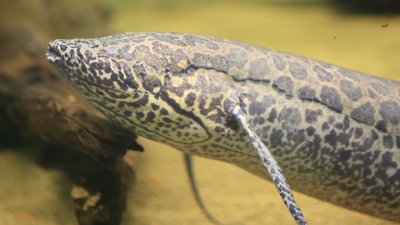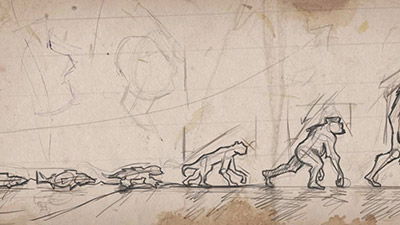Mystery of the Turtle Shell
The turtle is known for its slow speed. So was turtle evolution so slow that you can’t even see it?
News Source
- MSNBC/Discovery: “How the Turtle Got its Shell”
As is custom, it’s an evolutionary conundrum virtually no one hears about until it’s (supposedly) been solved: how did turtles evolve their trademark shells? Calling it “one of the biggest mysteries of the animal kingdom,” Discovery writer Michael Reilly explains how evolutionists just may have a resolved their conundrum well enough—for the time being.
The conundrum centers on turtles’ unique shells, which grow out of and are fused to their ribs.
The conundrum centers on turtles’ unique shells, which grow out of and are fused to their ribs. Was it always like this—did evolution encourage turtle ribs to flatten and spread out until they formed a complete shell? Or, as others suggest, were turtles originally more similar to armadillos, which have “dermal armor” that is actually thickened skin, not attached to their ribs?
A “bizarre” fossil found in New Mexico purportedly ends the debate, if Yale University paleontologist Walter Joyce is correct. Named Chinlechelys tenertesta and considered to be 215 million years old, the fossil is in bad shape. “It’s a pretty ugly fossil, really . . . almost like a shoebox full of crud,” Joyce lamented. But a fragment of the dorsal shell with ribs attached excites Joyce. “That’s what really gave it away: you can see that the ribs are not fused to the shell.”
In other words, Joyce believes this ancient creature was a turtle ancestor with dermal armor, unfused to the ribs. It may have looked like an ankylosaur, the well-known low-lying “tank”-like dinosaur. Furthermore, C. tenertesta could not retract its head or limbs, and its shell was thinner than a “modern” turtle’s. Meanwhile, it has spines running along its neck and tail.
“It is a missing link,” reported the Chicago Field Museum’s James Parham, who added that C. tenertesta may be one of the most important turtle fossils ever.
Our question—without having access to the actual fossil—is what makes it clear that this was indeed a proto-turtle fossil, as opposed to a unique (and now extinct) ankylosaur- or armadillo-like creature? After all, New Scientist reports that the fossil was only 12 inches (30 cm) long, with the shell fragment less than a sixteenth of an inch (1 mm) wide, and Joyce himself pointed out the poor state of the fossil. So, just as occurs with “apeman” fossils, we have a single piece of this tiny, “ugly,” may-have-been-a-turtle fossil being used to justify a lineage of unobserved evolution. Our guess is that this fossil wasn’t a turtle at all, but rather another reptile with dermal armor.
Our guess is that this fossil wasn’t a turtle at all, but rather another reptile with dermal armor.
An alternative hypothesis is that, if it could be confirmed that C. tenertesta is actually a turtle, perhaps this turtle merely had a harmful mutation that prevented the shell from forming properly, leaving the shell separate from (i.e., unsuccessfully fused to) the rib. But is this fossil even in good enough shape to make much of a judgment, other than that for this particular specimen, its shell wasn’t fused, whatever the creature was?
What’s more interesting is the pervasiveness of the “make up a story” mentality of many scientists in evolutionism. In this case, the Royal Society (parent to Proceedings of the Royal Society B, which published Joyce’s research) also printed a diagram showing how an ancient reptile could have evolved into the modern turtle. In it, we see all the “just-so” steps: the development of dermal armor, then a sudden leap to a fused dermal armor shell, then the loss of all dermal armor, leaving only the fully fused, smooth, modern shell.
So here’s how you concoct an evolutionary history: pick any two similar animals and describe a series of incremental changes (make sure they’re construed as advantageous) to change the first animal into the second. (Ignore the fact that mutations have never been shown to generate new functioning anatomical features.) Then find a tiny bit of fossil from either of the two animals and stick it in the supposed lineage (but not where the actual change happened, of course). If there are modern-day organisms that match up rather well with your ancient fossil, ignore the similarity or call it a living fossil.
Perhaps we’re being too harsh; after all, evolution is rooted in such controversial interpretations of sparse fossils and faith in the power of mutations. Meanwhile, the creation model explains this find just fine, thank you.
Further Reading
- The Origin of Vertebrates
- How Did Defense/Attack Structures Come About?
- Why Don’t We Find Human & Dinosaur Fossils Together?
For More Information: Get Answers
Remember, if you see a news story that might merit some attention, let us know about it! (Note: if the story originates from the Associated Press, FOX News, MSNBC, the New York Times, or another major national media outlet, we will most likely have already heard about it.) And thanks to all of our readers who have submitted great news tips to us. If you didn’t catch all the latest News to Know, why not take a look to see what you’ve missed?
(Please note that links will take you directly to the source. Answers in Genesis is not responsible for content on the websites to which we refer. For more information, please see our Privacy Policy.)
Recommended Resources

Answers in Genesis is an apologetics ministry, dedicated to helping Christians defend their faith and proclaim the good news of Jesus Christ.
- Customer Service 800.778.3390
- © 2024 Answers in Genesis








